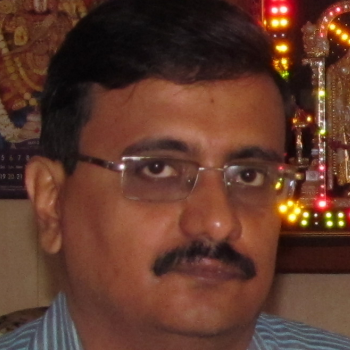
Souvik Bhattacharyya
Work place: Department Computer Science & Engineering,University Institute of Technology, Burdwan University, Burdwan, India
E-mail: souvikbha@gmail.com
Website:
Research Interests: Image Processing, Network Security, Network Architecture, Image Manipulation, Image Compression, Natural Language Processing
Biography
Souvik Bhattacharyya received his B.E. degree in Computer Science and Technology from B.E. College, Shibpur, India and M.Tech degree in Computer Science and Engineering from National Institute of Technology, Durgapur, India. Currently he is working as an Assistant Professor and In-Charge in Computer Science and Engineering Department at University Institute of Technology, The University of Burdwan. His areas of interest are Natural Language Processing, Network Security and Image Processing. He has published nearly 65 papers in International and National Journals / Conferences.
Author Articles
Study and Analysis of Text Steganography Tools
By Indradip Banerjee Souvik Bhattacharyya Gautam Sanyal
DOI: https://doi.org/10.5815/ijcnis.2013.12.06, Pub. Date: 8 Oct. 2013
"Maintain the security of the secret information", this words has been a great challenge in our day to day life. Sender can send messages regularly through a communication channel like Internet, draws the attention of third parties, hackers and crackers, perhaps causing attempts to break and expose the unusual messages. Steganography is a gifted region which is used for secured data transmission over any public media. Wide quantity of research work has been established by different researchers on steganography. Steganalysis is an art and science of detecting messages hidden using steganography. Some research work has also been remarked in the field of Steganalysis also. In this contribution, we have gone through steganalysis attack of some established text steganography tools.
[...] Read more.Text Steganography Using Quantum Approach in Regional Language with Revised SSCE
By Indradip Banerjee Souvik Bhattacharyya Gautam Sanyal
DOI: https://doi.org/10.5815/ijcnis.2012.12.08, Pub. Date: 8 Nov. 2012
In this contribution we present a work of text steganography. Maintain the security of the secret information has been a great challenge in our day to day life. Sender can send messages habitually through a communication channel like Internet, draws the attention of third parties, hackers and crackers, perhaps causing attempts to break and expose the unusual messages. Steganography is a talented province which is used for secured data transmission over any public media. Extensive amount of research work has been established by different researchers on steganography. In this paper, a text steganography procedure has been designed with the help of a Regional language of India i.e. Gujarati language. Here the quantum approach also incorporates for increasing the security level. A Revised SSCE code (SSCE - Secret Steganography Code for Embedding) has been implemented in this work to upgrade the level of security. Text steganography together with Revised SSCE code & quantum approach based on the use of two specific and two special characters in Gujarati language and mapping technique of quantum gate truth table have been used.
[...] Read more.Feature Based Audio Steganalysis (FAS)
By Souvik Bhattacharyya Gautam Sanyal
DOI: https://doi.org/10.5815/ijcnis.2012.11.08, Pub. Date: 8 Oct. 2012
Taxonomy of audio signals containing secret information or not is a security issue addressed in the context of steganalysis. A cover audio object can be converted into a stego-audio object via different steganographic methods. In this work the authors present a statistical method based audio steganalysis technique to detect the presence of hidden messages in audio signals. The conceptual idea lies in the difference of the distribution of various statistical distance measures between the cover audio signals and their denoised versions i.e. stego-audio signals. The design of audio steganalyzer relies on the choice of these audio quality measures and the construction of two-class classifier based on KNN (k nearest neighbor), SVM (support vector machine) and two layer Back Propagation Feed Forward Neural Network (BPN). Experimental results show that the proposed technique can be used to detect the small presence of hidden messages in digital audio data. Experimental results demonstrate the effectiveness and accuracy of the proposed technique.
[...] Read more.A Procedure of Text Steganography Using Indian Regional Language
By Indradip Banerjee Souvik Bhattacharyya Gautam Sanyal
DOI: https://doi.org/10.5815/ijcnis.2012.08.08, Pub. Date: 8 Aug. 2012
In this paper we present a work of text steganography. Now a days, maintain the security of the secret information has been a great challenge. Sender can send messages habitually through a communication channel like Internet, draws the attention of third parties, hackers and crackers, perhaps causing attempts to break and expose the unusual messages. Steganography is a promising region which is used for secured data transmission over any public media. Substantial amount of research work has been accepted by different researchers on steganography. In this paper, a text steganography procedure has been planned with the help of an Indian regional language i.e. Oriya language. Text steganography together with quantum approach based on the use of two specific characters and two special characters like invited comas (opening and closing) in Oriya language and mapping technique of quantum gate truth table have been used.
[...] Read more.A Robust Image Steganography using DWT Difference Modulation (DWTDM)
By Souvik Bhattacharyya Gautam Sanyal
DOI: https://doi.org/10.5815/ijcnis.2012.07.04, Pub. Date: 8 Jul. 2012
Maintaining the secrecy of information is of great concern today.Steganography is the art and science that hides the information in an appropriate cover carrier like image, text, audio and video media. Considerable amount of work has been carried out by different researchers on steganography. In this work a new transform domain image stenographic technique DWTDM is presented where secret data is embedded in adjacent DWT coefficient differences. The dynamic range of the DWT difference considered while extraction of data which results an efficient and robust stenographic technique which can avoid various image attacks and works perfectly well for both uncompressed and compressed domain. Experimental results demonstrate the effectiveness and accuracy of the proposed technique in terms of security of hidden data and various image similarity metrics.
[...] Read more.Other Articles
Subscribe to receive issue release notifications and newsletters from MECS Press journals